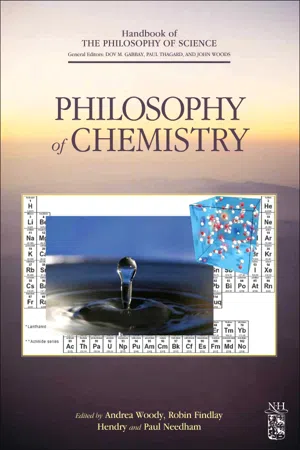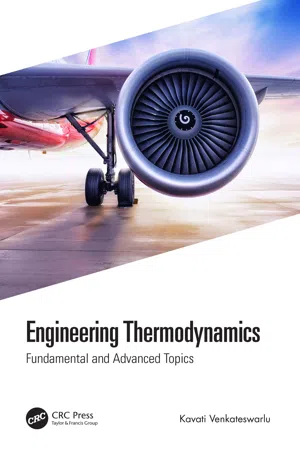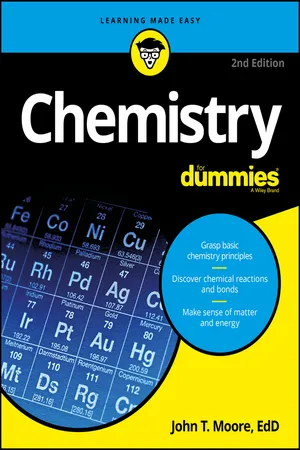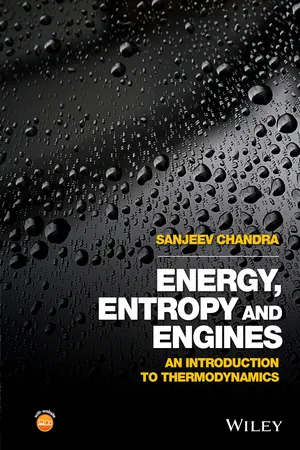Chemistry
Pure Substances
Pure substances are materials that are made up of only one type of particle, either atoms or molecules. They have a fixed composition and distinct chemical properties. Pure substances can exist in different phases, such as solid, liquid, or gas, and can be further classified as elements or compounds based on their chemical composition.
Written by Perlego with AI-assistance
Related key terms
Related key terms
1 of 4
Related key terms
1 of 3
6 Key excerpts on "Pure Substances"
- eBook - ePub
- Dov M. Gabbay, Paul Thagard, John Woods(Authors)
- 2011(Publication Date)
- North Holland(Publisher)
Ostwald [1907 , 166-170], if the properties of two coexisting phases remain invariant during a phase change, the system is called hylotropic; if not it is a solution (phase of variable composition). If it is hylotropic over a range of temperatures as the pressure varies, it is a pure chemical substance. If it is hylotropic only at a particular temperature and pressure, it is a special kind of solution, for example an azeotropic mixture. If it is hylotropic over all pressures and temperatures, except the most extreme ones, it is a simple substance; if not it is a compound.20 For critical but sympathetic discussion of their proposals see [Psarros, 1999 , 133n151; Schummer, 1996, 185n11], and the article on ‘Wald’ in Part 2 of this Volume.21 Of course such criteria break down if we move to the nanometer scale. Nevertheless it is assumed that a hybrid crystal in which two polymorphs coexist allows for separation in principle.22 Although the term “solution” originated with the observation that many liquids may form homogeneous mixtures, it is now also used for the solution of solids in one another. An ideal solution (of which there are few if any) has properties linear in composition. Save under the most exceptional circumstances, there can be only one gas/vapour phase.Against this operational background a pure substance can be defined as a substance of which properties such as density do not change during a phase conversion (as in boiling a liquid or melting a solid), which takes place at one constant temperature. Thus the melting point of a pure substance is a constant of nature, 23 even though it refers to one substance only and there are many such unique constants characterising (pure) chemical substances.23 Assuming the existence of absolutely Pure Substances (which may not exist).Operationally a substance is pure if it is perfectly homogeneous after being subjected to successive modes of fractionating which are as different as possible and when attempts at further purification produce no further change in properties. As already noted in the first section, later refinements may show that what was once thought to be a pure substance is, after all, not pure. As noted by many writers in the field, purity is a matter of negotiation or consensus. Different applications require different standards of purification. Different separation techniques (crystallisation, electrophoresis, and so on) set different standards of purity. 24 - eBook - ePub
Engineering Thermodynamics
Fundamental and Advanced Topics
- Kavati Venkateswarlu(Author)
- 2020(Publication Date)
- CRC Press(Publisher)
4 Properties of Pure SubstancesLearning Outcomes After learning this chapter, students should be able to- Understand the concept of a pure substance.
- Analyze the phase change phenomena useful in so many applications such as steam power plants.
- Illustrate the p-v, T-v, and p-T property diagrams and p-v-T surfaces of Pure Substances.
- Demonstrate the procedures for determining the thermodynamic properties of Pure Substances from tables of property data.
- Describe the hypothetical substance “ideal gas” and the ideal-gas equation of state.
- Apply the ideal-gas equation of state for typical problems.
- Introduce the compressibility factor, which accounts for the deviation of real gases from ideal-gas behavior.
4.1 Pure Substances and their Phases
A substance that has a fixed chemical composition throughout its volume is called a pure substance. A substance may be a single element or compound or a mixture of various chemical elements or compounds. A pure substance can exist in more than one phase, but its chemical composition must be the same in each phase. For example, water is a pure substance when it is in solid (ice), liquid (water), and vapor (gaseous) states separately and combinedly as water possesses the fixed ratio of hydrogen and oxygen. Similarly, air is also a pure substance as it possesses a uniform mixture of its constituents throughout its volume. Liquid air and air (gaseous) are not considered as Pure Substances because their compositions vary in the different phases.A substance exists in three different phases: solid, liquid, and gas. In a solid phase, the molecules are closely arranged and hence the attractive forces of molecules on each other are so high that they keep the molecules at fixed positions. There is no relative motion of molecules in solids; however, there is a continuous oscillation of molecules about their equilibrium positions. Temperature plays an important role during these oscillations. Liquids, like solids, have almost similar molecular structures as molecules are closely spaced; however, they differ in that molecules can rotate and translate freely apart from not having fixed positions relative to each other. Gases, on the other hand, have molecules spaced far apart when compared to both solids and liquids and molecules move randomly and collide continually with each other and with the walls in which they are contained. The molecules in the gas phase have higher energy levels when compared to the same molecules in solid or liquid phases. - eBook - ePub
- John T. Moore(Author)
- 2016(Publication Date)
- For Dummies(Publisher)
cold finger.Classifying Pure Substances and Mixtures
One of the basic processes in science is classification. As I discuss in the preceding section, chemists can classify matter as solid, liquid, or gas. But matter can be classified in other ways as well. In this section, I discuss how all matter can be classified as either a pure substance or a mixture (see Figure 3-2 ).FIGURE 3-2: Classification of matter.Keeping it simple with Pure Substances
A pure substance has a definite and constant composition or make-up — like salt or sugar. A pure substance can be either an element or a compound, but the composition of a pure substance doesn’t vary.Elementary, my dear reader
An element is composed of a single kind of atom. An atom is the smallest particle of an element that still has all the properties of the element. Here’s an example: Gold is an element. If you slice and slice a chunk of gold until only one tiny particle is left that can’t be chopped any more without losing the properties that make gold gold, then you’ve got an atom.The atoms in an element all have the same number of protons. Protons are subatomic particles — particles of an atom. Subatomic particles come in three major kinds, which Chapter 4 covers in great, gory detail.The important thing to remember right now is that elements are the building blocks of matter. And they’re represented in a strange table you may have seen at one time or another — the periodic table. (If you haven’t seen such a table before, it’s just a list of elements. Chapter 5 contains one if you want to take a peek.)Compounding the problem
A compound is composed of two or more elements in a specific ratio. For example, water (H2 O) is a compound made up of two elements, hydrogen (H) and oxygen (O). These elements are combined in a very specific way — in a ratio of two hydrogen atoms to one oxygen atom (hence H2 - eBook - ePub
Chemistry
With Inorganic Qualitative Analysis
- Therald Moeller(Author)
- 2012(Publication Date)
- Academic Press(Publisher)
element is a pure substance that cannot be converted into a simpler form of matter by any chemical reaction. Hydrogen and oxygen are elements; so are iron and sulfur. All of the known elements are listed on the endpapers of this book.Under the right conditions hydrogen and oxygen combine to form water. Heating a mixture of iron and sulfur causes them to combine to form iron sulfide, a substance with properties clearly different from those of either iron or sulfur (Figure 1.1b ). Both of these processes are chemical reactions, and the products are chemical compounds. A compound is a substance of definite composition in which two or more elements are chemically combined; a compound can be separated into its components by chemical reactions but not by purely physical methods.The general classification of matter is summarized in Figure 1.2 . We shall define the types of matter more accurately in later chapters.FIGURE 1.2 Classification of matter. By naturally occurring elements, we mean elements that are present in nature in even the minutest amounts. Four elements—technetium, astatine, francium, and promethium—although present, are so scarce that collecting a measurable amount is exceedingly difficult or impossible.Chemistry: The science of matter
1.4 Chemistry
Simply defined, chemistry is the science of matter. Chemistry is necessary in the study and manipulation of any material, and in our modern world we are surrounded by materials that have been studied, manipulated, and even invented by chemistry. Our automobiles are made of metals, fabrics, and plastics. Few of these materials can be obtained from natural sources in forms that are readily usable. The metals are recovered from mineral ores; the fabrics are produced from plant, animal, or synthetic fibers; the plastics are made by combining simple materials to form new and more complex materials.We travel on highways surfaced with asphalt and concrete. We drink water that has been purified with chlorine. We read from paper made from cellulose and printed with highly colored inks. We watch television screens that have been coated with tiny chemical spots, each of which responds with a color when energy is applied. With chemistry, we alter an almost endless variety of materials to form other materials with characteristics that we desire. - eBook - ePub
Energy, Entropy and Engines
An Introduction to Thermodynamics
- Sanjeev Chandra(Author)
- 2016(Publication Date)
- Wiley(Publisher)
Mass, volume, pressure and temperature are relatively simple to measure, but they are not all independent properties. If we heat a given mass of gas in a constant volume container its pressure rises along with temperature. We will derive relationships, known as equations of state, between the system pressure, temperature, mass and volume.Properties such as energy cannot be measured directly. The energy of a gas has to be calculated indirectly from measurements of temperature. We will discuss how to do this and show that simple models of the molecular structure of gases are useful in giving us insight into the relationship between energy and temperature.3.2 States of Pure Substances
A pure substance is one that has the same, distinct chemical composition everywhere: it may be a pure element or chemical compound. Examples of Pure Substances are oxygen, nitrogen, water and copper. A homogeneous substance has the same composition and properties throughout, but may be a mixture of several Pure Substances. Air, which is mixture of several gases, is treated as a homogeneous substance, as are metal alloys such as steel or brass. A solution of carbon dioxide dissolved in water is a homogeneous substance (Figure 3.1 a), but if you shake the flask so that the carbon dioxide comes out of solution and forms bubbles in the liquid (Figure 3.1 b), the system is no longer homogeneous since its composition is not uniform throughout. Samples taken from different locations in the flask will give different ratios of carbon dioxide and water and we call it a heterogeneous substance.Examples of (a) a homogeneous solution and (b) a heterogeneous mixture.Figure 3.1All matter consists of atoms or molecules that interact with each other by exerting forces known as interatomic or intermolecular bonds. The magnitude of these forces determines the state of any material. Pure Substances are commonly found in one of three different states: solid, liquid or gas. Solids have very strong intermolecular forces so the molecules are close together and their positions relative to each other are fixed (Figure 3.2 a). Liquids have weaker intermolecular forces and the molecules, though still close, are free to move so that liquids, unlike solids, can flow (Figure 3.2 b). Gases have very large spacing between the molecules, which are free to move randomly. Intermolecular forces in gases are so weak as to be negligible (Figure 3.2 - eBook - ePub
- Allan F.M. Barton(Author)
- 2021(Publication Date)
- CRC Press(Publisher)
CHAPTER 12MIXED MATTER
For most practical purposes in our daily activities we use mixtures of materials rather than pure compounds. Solutions (mixtures with a liquid as at least one of the components) are particularly important in environmental and biological systems as well as in industrial processes.12.1 Purity
As I have already emphasised in several contexts, it is important to understand the particular significance of words used in the description of scientific systems and their models. The apparently simple terms ‘pure substance’, ‘mixture’ and ‘solution’ often cause problems for new students. We all think we know what the word ‘mixture’ means, but even as used by chemists this term is rather ambiguous. One meaning is that it is a blend at an unspecified level of subdivision of two or more Pure Substances not linked by chemical bonds: not a compound. You can separate a ‘mixture’ of iron filings and sulphur powder with the aid of a magnet, but not the iron and sulphur in the compound iron sulfide. (A pure substance, when recovered from a mixture, retains its definite composition and specific properties. There are specific linkages between the atomic units of matter that we can most readily describe or model as ‘chemical bonds’.)Another meaning (the one I shall use here) is much stricter. In a mixture of two or more components the blend must be ‘homogeneous’ (uniform in composition—otherwise it is ‘heterogeneous’) right down to the molecular level, with a completely random distribution of the components. This is the meaning assumed when mixing is referred to as an equilibrium state in the thermodynamic model. When one of the components is a fluid (liquid or gas) we can achieve such a homogeneous mixture reasonably readily, but a thermodynamically defined mixture of two solid components is much more elusive.Chemists apply the term ‘solution’ to homogeneous mixtures in which there is more of one component (the ‘solvent’) than the other (the ‘solute’). If the interactions between solute and solvent are particularly strong, we say that the solute is ‘solvated’. Solvents and solutes may be gases, liquids or solids without restriction. When a polymer is in equilibrium with a liquid there must be two phases present. The liquid phase is a dilute solution of the polymer in the liquid and the polymeric phase is a dilute solution of the liquid in the polymer. Just as it is possible to have a metastable situation in a pure material that we ‘supercool’ to below its normal freezing point, it is possible also for a solution to become ‘supersaturated’. In other words, the solvent contains more solute than it would if the system were at equilibrium1 †
Index pages curate the most relevant extracts from our library of academic textbooks. They’ve been created using an in-house natural language model (NLM), each adding context and meaning to key research topics.
Explore more topic indexes
Explore more topic indexes
1 of 6
Explore more topic indexes
1 of 4





